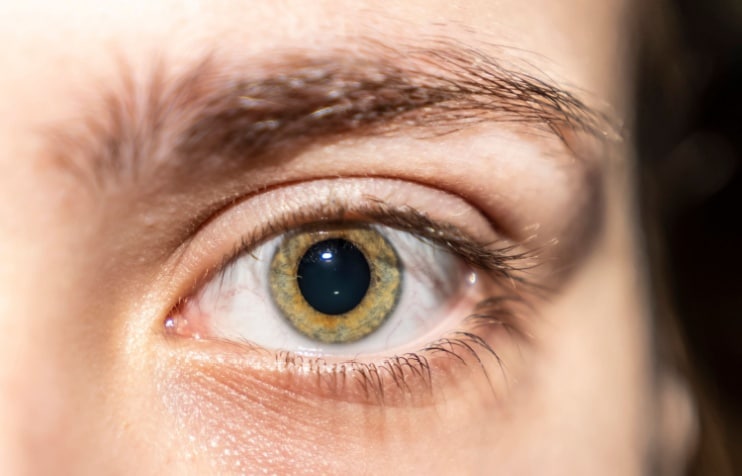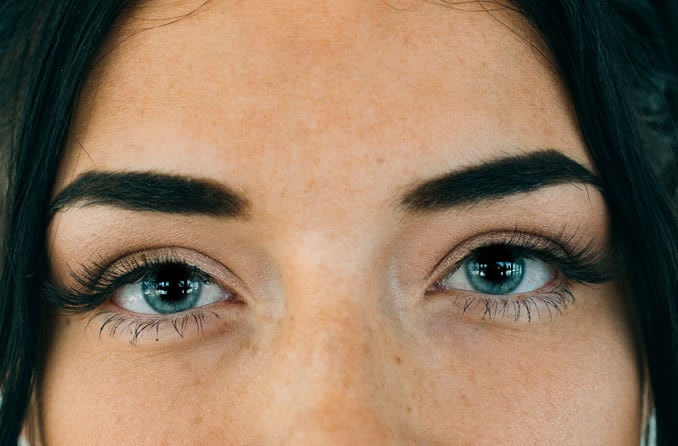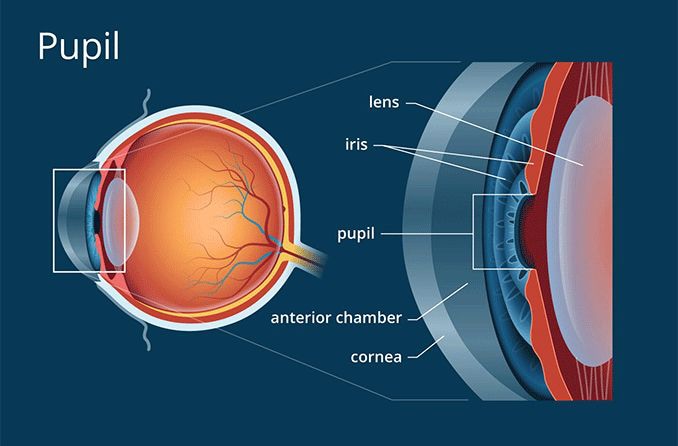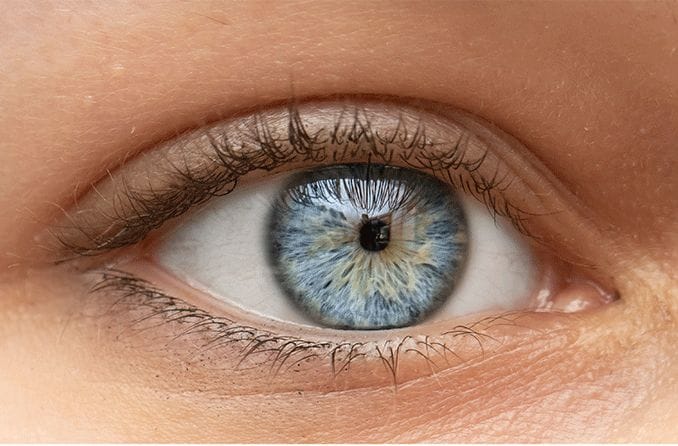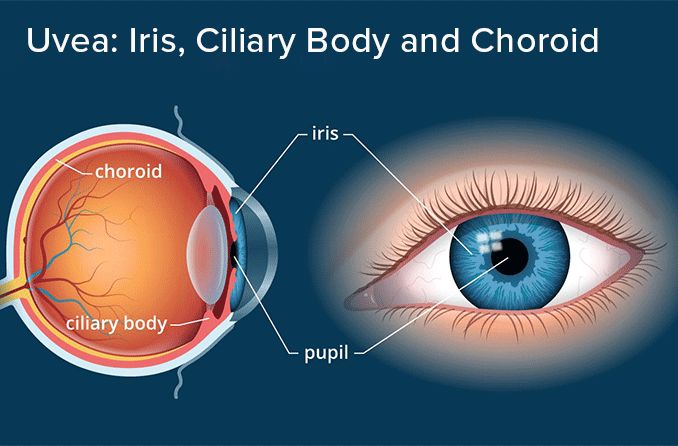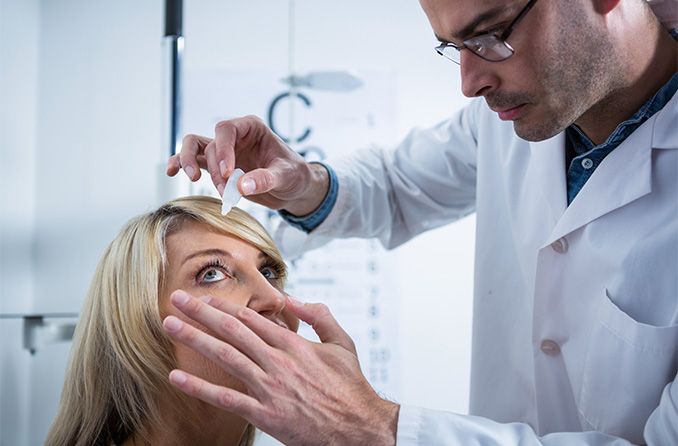What is mydriasis?
Mydriasis is when the pupil is dilated and unresponsive to light. It stays enlarged and fixed, regardless of light levels, due to a drug, disease, injury or other cause. The pupil is the black circle inside the colored part of the eye (the iris) that changes size to regulate light entering the eye.
Pupil dilation can occur in one or both eyes, depending on the cause. Under normal conditions, the pupils widen in dimly lit environments to allow more light into the eye. They get smaller in brightly lit environments to decrease the amount of light entering the eye.
Pupils can also dilate as a result of someone’s emotional state. With mydriasis, the pupils are dilated regardless of the amount of light present.
Mydriasis can be caused by many things. The application of dilating eye drops for a dilated eye exam is one common cause. Your eye doctor may use these drops to enlarge the pupil for a better view of the back of your eye.
However, sudden and unexplained mydriasis can indicate an underlying medical condition that requires immediate medical attention, especially if you also experience:
- Vision loss
- Headaches
- Nausea
- Eye pain
Mydriasis vs. miosis
Mydriasis is the dilation or widening of the pupil, while miosis is the constriction or narrowing of the pupil. Pupil size is controlled by the muscles of the iris:
- Dilator pupillae – Dilates the pupil, making it larger
- Sphincter pupillae – Constricts the pupil, making it smaller
These muscles are innervated by the autonomic nervous system, which is responsible for regulating involuntary bodily functions. The sympathetic branch of the autonomic nervous system (responsible for the “fight-or-flight” response) stimulates the dilator pupillae, causing the pupils to dilate.
Alpha-1 receptors are a type of adrenergic receptor found in various tissues in the body, including the iris of the eye. These receptors play a key role in the sympathetic nervous system, which is responsible for the body's "fight-or-flight" response. Drugs that bind alpha-1 receptors are called alpha-1 agonists. Some types, such as phenylephrine ophthalmic solution, may be used to dilate the pupils.
The parasympathetic branch is responsible for “rest-and-digest” functions. It stimulates the sphincter pupillae to constrict, resulting in small pupils. The balance between these two systems allows for the precise regulation of pupil size in response to changes in light intensity or emotional state.
How do you know if you have mydriasis?
The most obvious sign that you have mydriasis is that the pupil of one or both eyes is larger than usual. Someone with a dilated pupil may not notice it, so it is often pointed out to them by another person.
Typical pupil size ranges from:
- 2 to 4 millimeters under bright light conditions
- 4 to 8 millimeters in low-light conditions
If you have mydriasis, one or both of your pupils will measure 4 to 8 millimeters, even in a brightly lit setting.
You may also experience other symptoms depending on the cause of the dilation. Common symptoms associated with mydriasis include:
It's important to remember that these symptoms may not always occur at the same time, and their intensity may vary. Contact your doctor if you experience these symptoms and notice any sudden changes in your pupils.
Mydriasis causes
Mydriasis can occur for many reasons, including medications, injuries, eye conditions and other health conditions. Causes may include:
Dilated eye exams
Eye doctors use mydriatic eye drops to dilate the pupils during dilated eye exams. Dilation makes it possible to see the back of the eye more clearly and detect abnormalities. Common examples of mydriatic eye drops include:
- Tropicamide
- Cyclopentolate
These medicated drops work by acting on the iris muscles that control pupil size. The effects of the drops are temporary and usually wear off within a few hours, typically four to eight hours. Some individuals may remain dilated for up to 24 hours.
One side effect of dilating eye drops is cycloplegia. This refers to the temporary paralysis of the muscles that control the focusing of the lens in the eye, making it difficult to see up close.
Hormones
Hormones may influence pupil size, although these effects are not well understood. For example, increased levels of the hormone oxytocin can cause pupil dilation. Oxytocin is sometimes referred to as the “love hormone” because it is associated with positive social interactions. This hormone also plays a role in the reproductive system.
Medications
A number of medications can cause mydriasis as a side effect. These medications, called anticholinergics, block the action of acetylcholine, a neurotransmitter that plays a role in pupil constriction. Common examples include:
- Atropine, used to increase heart rate
- Scopolamine, used to treat motion sickness
- Antihistamines, used to treat allergies
- Selective serotonin reuptake inhibitors (SSRIs), used to treat depression
- Decongestants, used to relieve congestion
- Anti-seizure drugs, used to treat epilepsy
- Stimulant medications, used to treat ADHD
Serotonin syndrome
Dilated pupils can also be a symptom of a condition called serotonin syndrome. This serious and potentially fatal condition occurs when there is excessive activity of the serotonin receptors in the central nervous system (the brain and spinal cord).
It’s usually the result of a serotonin buildup, which may be caused by medication use, drug interactions or an overdose.
Medications that can affect your serotonin levels are typically prescribed to treat:
- Depression and anxiety
- Severe, chronic or acute pain
- Migraines
- Nausea
Recreational drugs
Several recreational drugs can cause the pupils to dilate because of their effects on the nervous system. Common examples include:
- LSD
- Cocaine
- Methamphetamines
- Ecstasy
- Psychedelic mushrooms
Injuries
An eye injury can result in a dilated pupil. This is called traumatic mydriasis. It can occur if the injury causes damage to the iris muscles or the nerves that control pupil size. These injuries include:
- Blunt trauma, like a punch to the face or a ball hitting the eye
- Head injuries
- Traumatic brain injuries
- A torn or blocked blood vessel in the neck
Eye conditions
An underlying eye condition can cause one or both pupils to dilate. Several eye conditions are associated with mydriasis, including:
- Adie's tonic pupil – A rare neurological condition where one pupil (in most cases) or both pupils dilate abnormally. Also called Adie’s pupil or Adie’s syndrome.
- Anisocoria – A condition in which one pupil is larger than the other. This may be the result of mydriasis in one eye. There are many underlying causes, and about 15% of the population will have anisocoria at some point.
- Third nerve palsy – This type of cranial nerve palsy causes impaired eye movement, a droopy eyelid and a blown pupil (a pupil that is abnormally dilated and unresponsive to light) in the affected eye. Third nerve palsy can be the result of a brain aneurysm. Someone with these symptoms should be taken to the emergency room immediately.
- Benign episodic unilateral mydriasis (BEUM) – This rare condition causes temporary, irregular pupil dilation in one eye. It is thought to be caused by an imbalance in the nervous system affecting the iris. BEUM is often associated with migraines.
Other medical conditions
Several medical issues can lead to dilated pupils. Conditions that affect the brain may cause a nervous system imbalance or pressure buildup that damages the nerves in the iris. This can cause mydriasis in one or both pupils.
Medical conditions that can cause dilated pupils include:
- Migraines
- Stroke
- Brain tumors
READ MORE: A guide to vision changes that can occur after a stroke
Mydriasis and glaucoma
Mydriasis is a risk factor for angle-closure glaucoma in certain individuals. This condition is most commonly observed in people with "narrow angles." This refers to an unusually narrow angle between the outer edge of the iris and the cornea, the eye’s clear front layer. Due to the increased risk of angle closure, eye doctors take special precautions when dilating patients with narrow angles.
Glaucoma is a group of eye diseases that damage the optic nerve, which sends signals from the eye to the brain. While open-angle glaucoma progresses slowly, angle-closure glaucoma can cause a sudden onset of pain in the eye, often accompanied by a headache, blurry vision and the appearance of halos around lights.
It is important to note that angle-closure glaucoma is considered a medical emergency. It requires immediate treatment to prevent permanent vision loss.
Mydriasis treatment and management
In most cases, dilated pupils will return to their normal size on their own. If mydriasis is caused by dilating eye drops, pupils will typically go back to normal after a few hours.
If treatment is required, it will depend on the underlying cause. If the pupil dilation is due to medication or recreational drug use, discontinuing the drug should return the pupils to normal once the effect of the substance wears off. If mydriasis results from a medical condition, treatment will focus on addressing that condition.
Management and treatment strategies include:
- Sunglasses – Dilated pupils can cause sensitivity to light. Wearing sunglasses, especially with photochromic or polarized lenses, can help reduce discomfort.
- Special contact lenses – Prosthetic contact lenses can improve appearance by making pupils appear more equal in size.
- Medication adjustment – If a medication is causing mydriasis, your doctor may recommend changing or adjusting the medication to resolve the issue.
- Treatment of underlying medical conditions – If a condition such as a brain tumor or stroke is causing mydriasis, treatment will focus on that disease.
- Eye drops – In some cases, eye drops may be used to help constrict the pupil.
- Surgery – Surgery may be required to repair damage from trauma or to address other underlying issues.
- Substance abuse rehabilitation – In cases where substance abuse is a cause, rehabilitation may be recommended.
When to see an eye doctor
Mydriasis usually goes away on its own. However, it can indicate a serious eye or brain issue such as head trauma, a tumor or a stroke. It is important to seek medical attention if you experience the following:
- Sudden or unexplained pupil dilation that doesn’t respond to changes in light levels
- Pupil dilation accompanied by severe headache, confusion or vision changes
- Pupil dilation following head or eye trauma
- Persistent pupil dilation not related to a recent eye examination
Being aware of the potential causes of mydriasis can alert you to seek medical care when necessary. Regular eye examinations can help detect potential eye conditions early and decrease the risk of vision loss. To help maintain healthy eyes and clear vision, schedule an appointment for a comprehensive eye exam.
